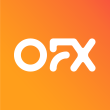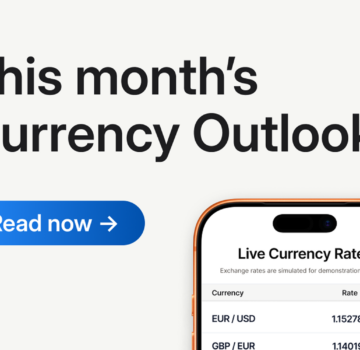Businesses of all sizes are looking for smarter ways to manage money across the borders. If you’re still juggling multiple bank accounts and paying inflated FX fees, it’s time to rethink your setup. A multi-currency account will help you manage global funds efficiently with fewer fees, faster payments, and better financial control.
This guide covers everything you need to know about multi-currency accounts, from how they work and who offers them, to how they can simplify your cross-border finance operations.
Summary:
• Why switch to a multi-currency account?
• Who offers multi-currency accounts?
• The challenges of multi-currency accounts
• Why a multi-currency account matters for your business
• The key benefits of a multi-currency account
• How a multi-currency account works
• How you can simplify cross-border finance
• How to choose the right multi-currency account
• The role of expense management software
• How to open a global (multi-currency) business account with OFX
• Final thoughts on multi-currency accounts
Why switch to a multi-currency account?
What is a multi-currency account? It’s a financial tool that allows you to hold, manage and transact in multiple currencies from a single account. Instead of opening separate foreign bank accounts in different countries, a multi-currency account makes it easy for you to manage several global currencies, all in one place.
A multi-currency account is a smart way to help scale your business internationally. According to a 2025 Mordor Intelligence industry report 1 , the global cross-border payments market is projected to reach US $315 billion by 2030. This highlights the growing need for efficient, cost-effective cross-border transaction tools and explains why optimizing expense management is essential in our global economy.
With OFX, you can hold, pay and receive money in 30+ currencies and get local details for 4 major international currencies: GBP, EUR, USD, CAD. The account holder can easily make transactions between different currencies while using just one account number.
Who offers multi-currency accounts?
Multi-currency accounts are offered by international payment providers and fintech platforms, and they are often paired with features like foreign exchange (FX) tools, local bank details and corporate debit cards for in-person payments and cash withdrawals. With the right provider, your multi-currency account can also integrate with your existing accounting software.
Some traditional banks also offer foreign currency accounts, but these accounts often charge high monthly fees, offer less competitive exchange rates, and may not support local bank details which makes it harder for overseas clients to pay you easily. They also typically don’t offer automation features or real-time FX tools, which means more manual effort and less control over your international cash flow.
Leading financial tech providers like OFX have revolutionised the global transfers space, offering user-friendly platforms with transparent pricing structures.
OFX provides access to competitive exchange rates, local bank details in multiple currencies, and zero monthly account fees* (*standard plan). You can hold and manage multiple currencies from a single account, automate currency conversions, and access real human support from an OFX specialist when needed.
With fewer hidden costs and more tools to streamline your spend management, cross-border business has become easier and more cost-effective.
OFX Global Business Account
Receive, hold, convert and send funds across a wide range of currencies, reduce costs and gain greater control over your international payments.

The challenges of multi-currency accounts
While multi-currency accounts offer powerful advantages for global businesses, they can come with a few challenges. Managing balances across different currencies requires careful cash flow planning to avoid idle funds or unexpected shortfalls. Exchange rate fluctuations can impact margins if not managed proactively with FX tools.
Additionally, not all providers offer the same level of transparency, integration, or customer support, making it important to choose a provider that fits your operational needs. Without the right setup, businesses can still face complexity, delays, or hidden costs. That’s why evaluating functionality, flexibility, and service is important when selecting your multi-currency partner.
Why a multi-currency account matters for your business
If your business works with international suppliers, contractors or customers, managing multiple currencies through traditional banking can quickly become expensive, time-consuming and prone to delays. A multi-currency account provides a streamlined, centralized way to hold and transact in different currencies, without the need for separate accounts in each country.
The benefits are both practical and strategic. With faster international payments and access to local account details in key markets, you can reduce the friction of cross-border transactions and improve the experience for partners, customers and your global teams. By avoiding constant currency conversions, you’ll also minimize foreign exchange (FX) fees and gain more control over how and when you convert currencies so you can avoid unfavorable rates.
A multi-currency account can also give you better visibility over global cash flow, simplify reconciliation and reporting, and reduce the administrative burden on your finance team. It offers a modern, digital-first alternative that helps your business operate with greater speed, accuracy and confidence.
The key benefits of a multi-currency account are:
- Faster international payments
- Lower FX fees
- Better visibility over cash flow
- Easier reconciliation and reporting
- Fewer delays than traditional banking networks
How a multi-currency account works
A multi-currency account simplifies the way your business handles global payments. Instead of managing a patchwork of international bank accounts or dealing with costly currency conversions every time you get paid, you can receive, hold, and send funds in multiple currencies from one central account.
For example, if you work with clients in the US, UK, Europe or Asia, you can receive payments in their local currency without immediate conversion. That means no surprise FX fees and more control over when and how you exchange money. You can also hold balances in key currencies, pay international vendors or contractors directly, and take advantage of better exchange rates using built-in foreign exchange tools.
Platforms like OFX provide access to local account details in major markets, allowing your clients to pay you like a local. The OFX multi-currency accounts also offer the ability to automate currency conversions, schedule payments, and even lock in exchange rates ahead of time.
The OFX Global Business Account includes advanced FX solutions and currency automation features to manage currency risk:
Forward Contracts – let you lock in a favourable exchange rate for up to 12 months, offering protection against market fluctuations and giving predictability to your budgeting.
Limit Orders – allow you to set a target rate for a transfer. OFX watches the markets and completes the transfer automatically once your rate is hit.
These tools enable you to automate currency conversions, schedule payments in advance, and manage your FX risk, all within your multi-currency account.
How you can simplify cross-border finance
Managing international finances without a multi-currency account can quickly become inefficient, and expensive. Using traditional banking methods often result in slow transfer times, limited fee transparency, and higher FX costs due to hidden bank margins.
Trying to manage global payments without a multi-currency account could make things harder than they need to be. You could face:
Higher costs: Traditional banks often add hidden margins to exchange rates, driving up your FX costs.
Slower transfers: Payments sent through slower methods or outside of typical banking hours could take several days to clear.
Unclear fees: It’s hard to keep track of what you’re being charged, especially when working with multiple banks or providers.
More admin: Managing different accounts for each currency can quickly become time-consuming and prone to mistakes.
A multi-currency account gives you more control, clearer visibility, and better efficiency so you can focus on running and growing your business, not chasing payments or fixing errors.
With the right setup, you can:
- Receive payments like a local (e.g. get paid in USD from US clients or GBP from UK clients without forced conversions)
- Hold and manage multiple currency balances
- Pay international vendors, contractors and employees
- Convert funds at competitive rates when you choose
How to choose the right multi-currency account
The right multi-currency account should give your business the flexibility, visibility, and cost-efficiency needed to grow internationally, without adding complexity. Here’s what to look for when comparing providers:
1. Supported currencies and countries
First, check that the account supports the currencies and regions your business operates in. Now, and where you plan to grow. A good provider will offer a broad range of major and emerging market currencies, with the ability to receive and hold funds locally.
2. Exchange rate transparency
Look closely at how the provider handles foreign exchange. Are the rates competitive? Are there hidden margins or fees? Transparent pricing and real-time FX tools can make a big difference to your bottom line, especially at scale.
3. Speed and reliability of payments
Global payments shouldn’t take days to arrive. Look for a provider that uses efficient, modern payment rails rather than relying solely on legacy networks like SWIFT. Faster, more reliable transfers mean happier clients, suppliers and teams.
4. Integration with your existing systems
A multi-currency account should simplify your workflow, not add to it. Make sure it integrates with your accounting software, such as Xero, QuickBooks or your ERP platform, so reconciliation, reporting and compliance are all easier to manage.
5. Security and regulatory oversight
Trust and security are critical. Choose a provider that’s licensed and regulated in all the jurisdictions they operate in. Look for additional security features such as multi-factor authentication and fraud prevention tools.
6. Customer support that understands you and your business
When it comes to international payments, responsive support matters. For businesses dealing with complex transactions or high volumes, hands-on support from a real human who understands your needs can be invaluable. You can talk to an OFX specialist now.
Extra tools that make a difference
Beyond the basics, the best providers offer added features that support growth and simplify global operations. These can include:
1. Forex risk management tools – Forward contracts and limit orders help you lock in favourable exchange rates or target specific rates, giving you more certainty over costs and margins.
2. Batch payment processing – Need to pay multiple vendors or contractors at once? Batch payments can save time and reduce manual errors.
3. Corporate cards with spend control – Make it easier for teams to manage business expenses while maintaining oversight on company spending, across multiple currencies.
The role of expense management software
Pairing a multi-currency business account with integrated expense management tools transforms how finance teams manage international spend. The OFX Business Full Suite plan offers streamlined features that help reduce errors, save time, and improve visibility, all within one unified platform.
An integrated expense management system tied to your OFX Global Business Account cuts out fragmented processes, reduces spreadsheet reliance, and gives your finance team the time and data needed to focus more on strategy and less on admin.
Why this matters:
- Automated expense categorisation – When receipts are uploaded or submitted via card, OFX’s system tags and sorts expenses automatically, reducing manual data entry and saving time.
- Real-time spend visibility across currencies – Track expenses across teams, currency balances, and custom budgets from one dashboard. Your finance team can see exactly where money was spent, in local or foreign currencies.
- Improved forecasting and budgeting – Access to live spend data helps you predict cash flow needs accurately and allocate budgets proactively.
- Streamlined approval workflows – Tailored approval chains ensure that invoices and expenses follow your internal policy, before payments are processed. This cuts bottlenecks and speeds up approvals.
- Faster month‑end reconciliation – With OFX’s native integrations, expenses and payments post automatically to Xero or QuickBooks, matching bills and receipts with ledger entries in near real-time.
Learn more about OFX tools
Spend management and expense tracking
AP automation and invoice approvals
Accounting software integration & reconciliation
Best practices: automate and streamline
Using a multi-currency account doesn’t mean adding more systems. The best solutions consolidate your finance tools, automate repeatable processes, and reduce manual errors:
- Automate currency conversions at preferred rates
- Set up approval workflows for team spending
- Sync transactions directly into your accounting system
- Use virtual cards or expense cards for tracking employee spend
- Automate remittance updates and reporting
How to open a global (multi-currency) business account with OFX
Creating your OFX Global Business Account, and opening multi-currency accounts, is a smooth, mostly online process. You can always count on your local OFX specialist if you have questions or need more clarification, but here’s how it works:
1. Register online and fill in your business details.
2. After registering, we’ll contact you to confirm the details, discuss which currencies you’ll transact in, and explain how multi-currency accounts work.
3. You’ll be guided to upload documents such as proof of identity and business registration. This process helps ensure regulatory compliance.
4. Account approval. Most OFX business accounts are approved within 4 business days, provided documents are complete and accurate.
5. Once approved, your global currency account details are delivered, usually within 2 business days. You’ll then be able to receive, hold, and send payments in multiple currencies.
6. Add currencies as needed. You can manage balances in 30+ currencies, with local details account available immediately for GBP, EUR, USD, and CAD. Additional currencies can be added via the transfer setup dropdown.
Why this setup works for businesses
Fast turnaround: From registration to receiving account details, most businesses are up and running within a week.
No hidden costs: There are no fees to open the account. OFX transparently shows the breakdown of the costs for transfers and currency conversions in the platform. You can view OFX pricing and fees here.
Built for global scale: Your OFX account supports 30+ currencies and allows you to receive and pay like a local in major markets from one dashboard.
Once your account and relevant currencies are activated, you can start receiving local payments, making global transfers, converting currency at competitive rates, and integrating with your accounting systems. For businesses just like yours, this means smoother expense management, improved cashflow control, and streamlined global operations.
Final thoughts on multi-currency accounts
A multi-currency account can be a valuable asset when set up with the right tools and partner. Paired with smart expense management systems and FX tools, it turns cross-border complexity into clarity. The OFX Global Business Account is about working smarter, not harder, and staying ahead in a global market.
If managing global expenses feels harder than it should, find out how OFX can help simplify your international finances. Enjoy competitive rates, multi-currency accounts, and integrated payment solutions that are built for your business.
Open an OFX Global Business Account
Make international payments easy
References
- https://www.mordorintelligence.com/industry-reports/cross-border-payments-market



